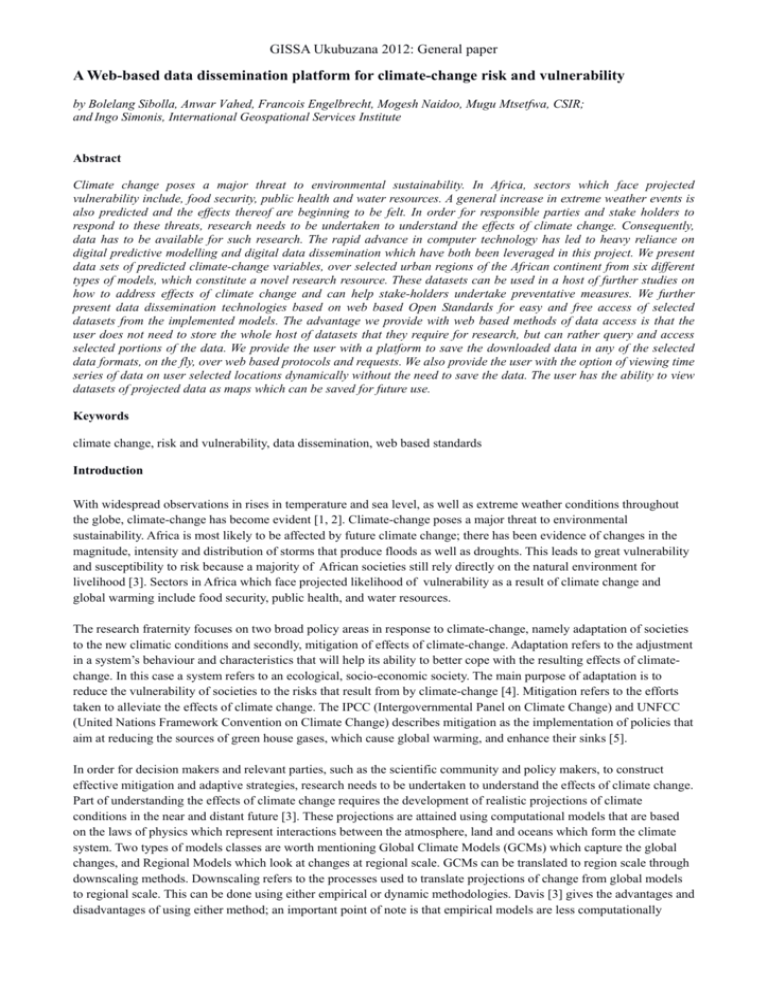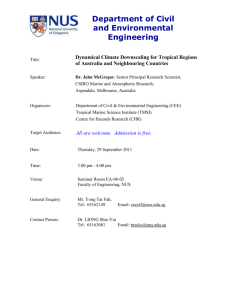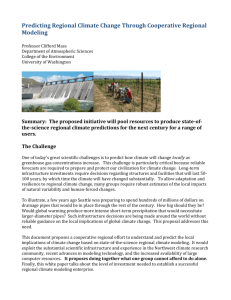A Web-based data dissemination platform for climate
advertisement

GISSA Ukubuzana 2012: General paper A Web-based data dissemination platform for climate-change risk and vulnerability by Bolelang Sibolla, Anwar Vahed, Francois Engelbrecht, Mogesh Naidoo, Mugu Mtsetfwa, CSIR; and Ingo Simonis, International Geospational Services Institute Abstract Climate change poses a major threat to environmental sustainability. In Africa, sectors which face projected vulnerability include, food security, public health and water resources. A general increase in extreme weather events is also predicted and the effects thereof are beginning to be felt. In order for responsible parties and stake holders to respond to these threats, research needs to be undertaken to understand the effects of climate change. Consequently, data has to be available for such research. The rapid advance in computer technology has led to heavy reliance on digital predictive modelling and digital data dissemination which have both been leveraged in this project. We present data sets of predicted climate-change variables, over selected urban regions of the African continent from six different types of models, which constitute a novel research resource. These datasets can be used in a host of further studies on how to address effects of climate change and can help stake-holders undertake preventative measures. We further present data dissemination technologies based on web based Open Standards for easy and free access of selected datasets from the implemented models. The advantage we provide with web based methods of data access is that the user does not need to store the whole host of datasets that they require for research, but can rather query and access selected portions of the data. We provide the user with a platform to save the downloaded data in any of the selected data formats, on the fly, over web based protocols and requests. We also provide the user with the option of viewing time series of data on user selected locations dynamically without the need to save the data. The user has the ability to view datasets of projected data as maps which can be saved for future use. Keywords climate change, risk and vulnerability, data dissemination, web based standards Introduction With widespread observations in rises in temperature and sea level, as well as extreme weather conditions throughout the globe, climate-change has become evident [1, 2]. Climate-change poses a major threat to environmental sustainability. Africa is most likely to be affected by future climate change; there has been evidence of changes in the magnitude, intensity and distribution of storms that produce floods as well as droughts. This leads to great vulnerability and susceptibility to risk because a majority of African societies still rely directly on the natural environment for livelihood [3]. Sectors in Africa which face projected likelihood of vulnerability as a result of climate change and global warming include food security, public health, and water resources. The research fraternity focuses on two broad policy areas in response to climate-change, namely adaptation of societies to the new climatic conditions and secondly, mitigation of effects of climate-change. Adaptation refers to the adjustment in a system’s behaviour and characteristics that will help its ability to better cope with the resulting effects of climatechange. In this case a system refers to an ecological, socio-economic society. The main purpose of adaptation is to reduce the vulnerability of societies to the risks that result from by climate-change [4]. Mitigation refers to the efforts taken to alleviate the effects of climate change. The IPCC (Intergovernmental Panel on Climate Change) and UNFCC (United Nations Framework Convention on Climate Change) describes mitigation as the implementation of policies that aim at reducing the sources of green house gases, which cause global warming, and enhance their sinks [5]. In order for decision makers and relevant parties, such as the scientific community and policy makers, to construct effective mitigation and adaptive strategies, research needs to be undertaken to understand the effects of climate change. Part of understanding the effects of climate change requires the development of realistic projections of climate conditions in the near and distant future [3]. These projections are attained using computational models that are based on the laws of physics which represent interactions between the atmosphere, land and oceans which form the climate system. Two types of models classes are worth mentioning Global Climate Models (GCMs) which capture the global changes, and Regional Models which look at changes at regional scale. GCMs can be translated to region scale through downscaling methods. Downscaling refers to the processes used to translate projections of change from global models to regional scale. This can be done using either empirical or dynamic methodologies. Davis [3] gives the advantages and disadvantages of using either method; an important point of note is that empirical models are less computationally GISSA Ukubuzana 2012: General paper intensive. Downscaling is increasingly being used for assessing regional climate change projections. It is worth noting that the results of downscaled projections are only as good as the results of the input GCM model and that the results of each projection come with some level of uncertainty, expectedly so because it is a likelihood of possible future events. Climate change projection models are generally long duration computations and they output very large datasets that must be further analysed [6]. Modelling continues to take advantage of the rapid advances in computer technology, and currently, most notably high performance computing. The data outputs from these models are spatio-temporal datasets. These datasets also need to be coordinated and disseminated in such a way that they are accessible by all interested parties irrespective of their location. Some examples of web based climate change data and information providers focused on the regional level in the northern hemisphere are: The National Centre for Atmospheric Research (NCAR) GIS Initiative that serves global Climate Change System Model (CCSM) projections as well as statistically downscaled projections and derived data products of key meteorological variables for the United States [7] The UK Climate Projections Report (UKCP09) providing climate change projections on a range of climate-change variables at a 25 km grid for three emission scenarios [8]. The next section describes the aim and objectives of this research. This is followed by a description of the methodology for generating the datasets, and a discussion on how the products are generated. A description and discussion on the dissemination of the data follows, and lastly, conclusions to the study thus far are presented. Objectives This research is in response to the lack of analytical research output on climate change risk and vulnerability in Africa. The possible reason behind this limited research output is the lack of data at appropriate resolution which would aid in addressing the threat to environmental sustainability. Besides the lack of data, there is a lack of infrastructure to gain fast access to it in order to perform analysis. The objectives of this research are: To generate regional climate change projection data at medium (60 to 80 km) and high resolution (8 km) To implement a web based data dissemination environment that benefits both low and high bandwidth users in Africa. The aim is to assist in the creation of an environment that enables more rapid exploration of the environmental, social and economic impacts and risks of climate-change-induced hazards that are likely to affect African urban areas. Such hazards include floods, sea-level rise, droughts, heat-waves, desertification, storms, vegetation fires as well as epidemics and pandemics. Projection models This section discusses the model projections, the design of the model projections methodologies and finally the results acquired from the projections. Model description The generation of the climate-change projection data presented here, also constitutes a contribution to a project entitled “Climate Change and Urban Vulnerability in Africa” (CLUVA), co-funded by the European Commission under the Seventh Framework Programme call on Environment (including climate change) . This work involves the downscaling of an ensemble of six global projections of future climate change, as obtained from coupled global climate models (CGCMs) that contributed to the IPCC Assessment Report 4 (AR4), to a higher resolution of about 60 to 80 km over the entire African continent [9]. A dynamic regional climate model is used for this purpose. The downscaling is performed for the period 1961 – 2100. Through the process of multiple nudging, these projections are downscaled further to a resolution of about 8 km over areas of interest that include the cities selected as case studies in CLUVA. These cities are Addis Ababa (Ethiopia), Dar es Salaam (Tanzania), Ouagadougou (Burkina Faso), St Louis (Senegal) and Douala (Cameroon). In total, an ensemble of six very high resolution simulations is constructed for areas surrounding all the CLUVA areas of interest. Through the collaboration between the Euro-Mediterranean Center for Climate Change (CMCC) in Italy and the Council for Scientific and Industrial Research (CSIR) in South Africa, a multi-model ensemble of eight high-resolution simulations of climate and climate change are derived (two at CMCC and six at the CSIR). A multi-model ensemble of GISSA Ukubuzana 2012: General paper simulations of present-day and future climate is available for each of the cities. The data sets produced, will be most useful to describe the range of uncertainty associated with future climate for each of the cities. The model simulations of present-day climate are verified against observations and an associated model intercomparison study is performed. Some impact studies over urban areas require plausible scenarios of future climate at ultra-high spatial resolution of one kilometre or less. For this purpose the regional scenarios will be downscaled further to 1 – 2 km resolution, using specific and accurate statistical techniques, such as a novel spectral-based stochastic downscaling technique. Ultra-high resolution projections are to be performed over one or two of the cities, through the dynamic downscaling of the 8 km resolution simulations. Experimental design The conformal-cubic atmospheric model (CCAM) of the Commonwealth Scientific and Industrial Research Organisation (CSIRO) is used to perform the dynamic downscalings. CCAM is a variable-resolution atmospheric global circulation model. When applied in stretched-grid mode, it effectively functions as a regional climate model. The model is highly suitable for the purpose of regional climate modelling, due to its computational efficiency and variableresolution formulation that allows great flexibility in downscaling CGCM data, through the application of a multiple nudging technique [10]. The model’s ability to simulate the present-day characteristics of African climate has been investigated over Africa [11] and for various other climate regions (e.g. [12, 13]). A four-phase multiple downscaling strategy is followed to obtain 200 km, 60 – 80 km and 8 km and eventually, 1 km resolution simulations. The first phase in the downscaling procedure requires that the model be forced with the seasurface temperature (SST) and sea-ice output of a number of different CGCMs used in AR4 of the IPCC, for the period 1961 – 2100. All the projections performed at the CSIR are for the A2 emission scenario of the Special Report on Emission Scenarios (SRES). The multiple-nudging strategy followed first involves the integration of CCAM globally at quasi-uniform C48 resolution (about 200 km in the horizontal as shown in Fig. 1), forcing the model with the SSTs and sea-ice of each host model, and with CO2, sulphate and ozone forcing consistent with the A2 scenario. Fig. 1: Quasi-uniform C48 CCAM grid with a horizontal resolution of about 200 km. In a second phase of the downscaling, the model is integrated in stretched-grid mode over Africa (Fig. 2), with the modestly-stretched grid providing a resolution of about 50 to 80 km over Africa. The higher resolution simulations are nudged within the quasi-uniform C48 simulations, through the application of a digital filter using a 4000 km length scale. The filter was applied at six-hourly intervals and from 900 hPa upwards. These first two phases of the downscaling procedure have been completed. Model output for the 200 km resolution ensemble members is available at six-hourly intervals, whilst output for the 60 to 80 km resolution simulations is available at hourly intervals for selected variables. Subsequent downscaling to 8 km is currently under-way and will be followed by the 1 km resolution. GISSA Ukubuzana 2012: General paper Fig. 2: Stretched high-resolution conformal-cubic-grid, horizontal resolution of about 60 – 80 km over Africa. Model results The available computing power at the CSIR has allowed the completion of six high resolution (60 km to 80 km horizontally) simulations over the African continent. The simulations cover the period 1961 – 2100. Analysis of these simulations and their subsequent downscaling to very high spatial resolution (8 km) over the CLUVA areas of interest are currently in progress. Fig. 3 shows the model projections, from the six ensembles, of the annual change in rainfall over the central part of Africa, for the year 2012. The six ensemble members project a robust pattern of rainfall increases over this region. Note that the projections are available continuously for any time-stamp within the period 1961 – 2100. Fig. 3: Six CCAM projections of changing annual rainfall patterns over parts of Africa for year 2012. GISSA Ukubuzana 2012: General paper The coupled models for which downscaling are presented in Fig. 3, are as follows: CCAM-CSIRO mk3.5: Version 3.5 of the Coupled Global Climate Model (CGCM) by the Commonwealth Scientific and Industrial Research Organisation in Australia (CSIRO) [12] CCAM-UKHADcm3: The third version of the United Kingdom’s Met Office Hadley Centre Coupled OceanAtmosphere Global Climate Model [14] CCAM-GFDLcm2.0 and CCAM-GFDLcm2.1: Versions 2.0 and 2.1 of the Coupled Global Climate Model of the Geophysical Fluid Dynamics Laboratory (GFDL) of the National Oceanic and Atmospheric Administration in USA [15] CCAM-ECHAM5: The fifth generation climate model developed by the Max Planck Institute in Germany [16] CCAM-MIROmr: The MIROC3.2-medres Model for Interdisciplinary Research on Climate 3.2, medium resolution version, of the Japanese Agency for Marine-Earth Science and Technology [17] Dynamic climate models typically output a wide range of meteorological variables throughout the troposphere and into the lower stratosphere. In addition to the meteorological variables, simulations are also performed for land-surface variables (e.g. soil moisture) that influence atmospheric processes. The three-dimensional spatial structure of meteorological data, in combination with the high temporal resolution of the data sets, leads to these data sets being very large. The datasets are in the order of tens of terabytes. The model projections are conducted on the CSIR’s Centre for High Performance Computer (CHPC). Utilising 36 processor clusters of 3,6 GHz each, the total simulations required three months of computing time to produce the complete variable set for the ensemble. The data set in its original form was about 80 TB in size. These downscalings represent the state-of-the-art in the application of a dynamic climate model, to obtain projections of future climate change. The CSIR has now commenced with the downscaling of the CGCMs for the Coordinated Regional Downscaling Experiment (CORDEX), an experiment through which the new set of CGCMs of Assessment Report 5 (AR5) of the IPCC are downscaled to a number of areas – including the African continent. Data dissemination Once the model projections have been computed, the raw output data needs to be converted to more user friendly, and storage saving formats, and then it is made widely and freely available through the World Wide Web. This chapter discusses the post processing that is performed on the raw data, followed by the data dissemination methods used. Data post processing Most climate variables required for climate-change impact studies and application modelling are ones that describe the state of the lower troposphere. Such variables include rainfall, minimum and maximum temperature, wind speed, relative humidity, evaporation, soil moisture and run-off. Storing the surface variables requires significantly less space than archiving the full three-dimensional data sets. For example, a single projection for the African continent at a horizontal resolution of 0,5 degrees (about 60 km) and with about 20 levels in the vertical, saving output at 12-hourly intervals (1-hourly interval for the surface variables), requires about 2 TB of storage space. Storing only the key surface variables as output reduces the size of the data set to about 100 GB. Output from the CCAM models is spatio-temporal data, in the form of NetCDF files. The data is available on the model’s conformal cubic grid (Fig. 2) and in stretched-mode; the grid resolution varies between 60 and 80 km. For effective dissemination of this data, the output data was converted to WGS84, a longitude and latitude based coordinate system, and the native projection was removed. This is necessary to allow easy display and analysis using common GIS and display packages. Conversion from CCAM native projection to uniform grid resolution was achieved through a CSIRO developed interpolation routine. This routine enables the interpolation of data from the conformal cubic grid to a regular latitude-longitude grid for any sub-domain of choice on the globe. Web based data portal A web based data portal is developed to facilitate the sharing and access of the datasets discussed in the previous sections. The web portal is organised into different divisions that will be discussed in the following sections. Data access An extensive communications infrastructure is necessary for the dissemination of full data sets. The data access framework is designed to cater for low bandwidth users in most African countries and also to meet the needs of users who have access to high bandwidth. Data is available directly for download on an ftp server that is available through a web portal. The data files available over ftp are organised in daily, monthly or yearly temporal resolutions for the period ranging 1961 to 2100. CCAM outputs a value at the end of each model day. These values (31 in, for example, the month GISSA Ukubuzana 2012: General paper of January) are then averaged over the month of concern to create a monthly file. The same concept is applied to yearly files; these are an aggregate of monthly files. This reduces file size dramatically, with data set size for a single variable of monthly average being ~28 kB. Organising data in this format gives the user freedom to choose which data to download depending on how much storage space they have. For example if one is interested in daily files they need not download the yearly files as well. In some cases a user does not have enough storage capacity to download the entire dataset for the entire time span 1961 to 2100. An OPeNDAP server, to meet the needs of these users, has thus been implemented. OPeNDAP (Open Source Project for a Network Data Access Protocol) is a frame work that facilitates scientific data networking and is often used by, although not restricted to, earth scientists. OPeNDAP provides free client side and server side software and tools which enable others to view local data in a remote location. The OPeNDAP protocol is based on HTTP (Hypertext Transfer Protocol), thus data on the server is accessible using a URL [18, 19, 20]. Data on OPeNDAP servers is usually in NetCDF (Network Common Data Format) or HDF (Hierarchical Data Format) formats [21, 22]. Datasets are supplied with native format as NetCDF in COARDS and CF compliant format. The COARDS (Cooperative Ocean/Atmosphere Research Data Service) is a standard for sharing and distributing global atmospheric and oceanographic research data sets and is extended by the CF convention. CF (Climate and Forecast) is a NetCDF metadata Convention. These are generally accepted NetCDF data standards by the climate and oceanographic communities [23]. Hence any CF and COARDS compliant dataset can be stored or read by an OPeNDAP server or client respectively. A python based version of OPeNDAP, PyDAP, is implemented. PyDAP is a python library for implementing the Data Access Protocol [24]. It can be used same way as OPeNDAP. The implementation of PyDAP as a client is used in conjunction with other web scripting tools (e.g. javascript and php) to develop an “on the fly” data access tool. It allows the user to slice through the netCDF files and download only the spatial and temporal extends in which they are interested. A user has the option to download the data in native netCDF format as well as additional formats such as Ascii and CSV (comma separated values) allowing the user to save storage space. Fig. 4 is an illustration of the PyDAP based user interface for data access and download. Fig. 4: Data slicing tool, showing user selection panel on the left. Data visualization An option to preview a data selection before download is provided in case where a user is interested in exploring the data before making the decision to download. The available options to a user are: to view the entire spatial extents for a selected period, or view a selected extent over a selected time period. The selection of area and time of interest is done through the same pydap technique that is discussed in the previous section. A visual extension to the PyDAP framework has been developed internally to implement the user selection based data viewing capability on the web portal. The data can be viewed in continuous raster format or as isolines for the particular variable. This data can also be exported to other formats such as tiff, jpeg, png. Having noted that the environmental sciences research community is familiar with Google Earth and that they use it in their research, an option to export the data in kml format such that it can be overlaid in the Google Earth environment is offered. Fig. 5 shows the data exported in kml format and overlaid on Google earth. GISSA Ukubuzana 2012: General paper Fig. 5: Generated kml file overlayed on Google Earth. Dynamic images of some selected variables for the time period 1961 – 2100 are also generated. A dynamic OGC WMS (Web Map Service) with temporal extension is implemented to facilitate browsing through data in this manner. This allows the user to browse through the years for a specific dataset in pictorial form on the fly as illustrated in Fig. 6. Fig. 6: Dynamic WMS with time extension. A Web Map Service renders the geographic data as a map, and this map can be saved in pictorial formats such as jpeg, giff, png. An OGC WMS is an internationally accepted standard that consist of and defines three service operations: Metadata, Map, and optionally information about features on a map. These can be invoked using a URL (Uniform Resource Locator). The composition of such a URL depends on what service operation is requested. To give an example, the URL of a map request will specify amongst others, the reference coordinate system, the spatial extents to be mapped as well as the data to be shown on a map [26]. The dynamic WMS are available in map and metadata request options. GISSA Ukubuzana 2012: General paper Time series viewer The time series viewer is a graphical tool for visualising and inspection of time series data. The time series viewer allows the user to select a location on a map that represents the available data and then displays a dynamic graph for the data. This is useful if the user does not want to download the data but rather wants to examine it, for example to see the trend in rainfall change for an available time period. The time series viewer allows dynamic on the fly access to the data without the need to download. The functionality to view two or more ensemble results for the same variable on one chart is currently under development. This will allow researchers to be able to compare the different model results for the available variables over the entire available temporal range. Fig. 7 is an illustration of the time series viewer showing projected precipitation at a particular (longitude, latitude) location from 1961 to 2100. The viewer provides zoom in tools to view shorter ranges on the graph interactively. Fig. 7: Time series viewer showing the precipitation projections 1961-2100 for CSIRO ensemble. Conclusions This research has thus far highlighted and addressed the possible challenges that hinder climate change research in Africa. We have provided climate change projections data sets for air temperature, precipitation, relative humidity, soil moisture wind speed and some static variables. These variables have been identified by consulting climate change researchers as the most important to assess issues that relate to risk and vulnerability that results from climate-change. These data sets have been provided at medium to high resolution so far and further higher resolution downscalings will be performed. We then provide web based mechanisms to distribute this data to interested parties irrespective of location to facilitate and encourage data sharing and collaborative research. The purpose of this is such that researchers can perform further analysis and contribute to the understanding of the effects of climate change in African urban areas, specifically, as these are the most highly populated areas in Africa. References [1] [2] [3] [4] [5] Intergovernmental Panel on Climate Change (IPCC): “Fourth Assessment Report: Climate Change”, 2007 (AR4), IPCC Secretariat, World Meteorological Organization (WMO) Switzerland, http://www.ipcc.ch/publications_and_data/publications_and_data_reports.shtml J. T. Houghton ,Y. Ding, D. J. Griggs, M. Noguer, P. J. van der Linden, X. Dai, K. Maskell, C. A. Johnson: Climate change 2001: the scientific basis. New York: Cambridge University Press, 2001. C. L. Davis: Climate Risk and Vulnerability: A handbook for Southern Africa. Pretoria, South Africa: Council for Scientific and Industrial Research, 2011. B. Smit and J. Wandel: “Adaptation, adaptive capacity and vulnerability” Global Environmental Change, vol.16, pp. 282-292, March 2006. J. Ford and B. Smit: “A Framework for assessing the Vulnerability of Communities in the Canadian Arctic to Risk Associated with climate change,” Arctic, vol.57, no. 4, pp. 389-400. December 2004. GISSA Ukubuzana 2012: General paper [6] [7] [8] [9] [10] [11] [12] [13] [14] [15] [16] [17] [18] [19] [20] [21] [22] [23] [24] [25] A. Chervenak, E. Deelman, C. Kesselman, B. Allcock, I. Foster, V. Nefedova, J. Lee, A. Sim, A. Shoshani, B. Drach, D. Williams, D. Middleton: “High Performance remote access to climate simulation data: A Challenge problem for data grid technologies,” Parallel Computing vol. 29, pp.1335-1356, 2003. National Center for Atmospheric Research (NCAR), Geographic Information Systems (GIS) Initiative, Boulder, Colorado, USA, http://www.gis.ucar.edu/atmo_data.jsp. UK Department for Environment Food and Rural Affairs (DEFRA), “United Kingdom Climate Change Projections (UKCP09)”, UK, http://ukclimateprojections.defra.gov.uk/content/view/868/531/. F. A. Engelbrecht, W. A. Landman, C. J. Engelbrecht, S. Landman, M. M. Bopape, B. Roux, J. L.McGregor and M. Thatcher: “Multi-scale climate modelling over Southern Africa using a variable-resolution global model”. Water SA. Vol. 37, No.5. 2011 http://dx.doi.org/10.4314/wsa.v37i4.18. J. L. McGregor: C-CAM: Geometric aspects and dynamical formulation. CSIRO Atmospheric Research Tech. Paper No. 70, 43 pp. 2005. F. A. Engelbrecht, J. L. McGregor, and C. J. Engelbrecht: “Dynamics of the conformal-cubic atmospheric model projected climate-change signal over southern Africa” International Journal of Climatology, vol. 29, pp.1013-1033, June 2009. M. Nunez and J. L. McGregor: “Modelling future water environments of Tasmania, Australia”. Climate Research, vol. 34, pp. 25-37. June 2007. M. Lai, J. L. McGregor and K. C. Nguyen: “Very high resolution climate simulation over Fiji using a global variable-resolution model”. Climate Dynamics, vol. 30, pp. 293-305. February 2008. T. C. Johns: “The new Hadley Centre climate model,” Journal of Climate, UK National MeteorologyLaboratory, vol. 19 , no.7, pp.1327-1353, April 2006. Geophysical Fluid Dynamics Laboratory, 2007, GDFL Global Atmospheric Model, Princeton University, Princeton, USA, http://www.gfdl.noaa.gov/ . Accessed August 2011. E. Reockner, G. Bauml, L. Bonaventura, R. Brokpof and M. Esch: “The atmospheric general circulation model ECHAM5 – Part 1”, Max Plank Institute for Meteorology, http://www.mpimet.mpg.de/fileadmin/publikationen/Reports/max_scirep_349.pdf. Accessed February 2012. J-L. Lin, T. Shinoda, T. Qian, W. Han, P. Roundy and Y. Zhen: “Intraseasonal variation of winter precipitation over the western United States simulated by 14 IPCC coupled models,” Journal of Climate, vol. 23, pp. 3094-3119, June 2010, doi: http://dx.doi.org/10.1175/2009JCLI2991.1. P. Cornillon, and J. Gallagher and T. Sgouros: “OPeNDAP: Accessing data in a distributed, heterogeneous environment”. Data Science Journal. 2, 164-174. November 2003. OpeNDAP Documentation. Online: http://www.opendap.org. Accessed: August 2012. HTTP-Hypertext Transfer Protocol. Online: http://www.w3.org/protocols. Accessed: August 2012. NetCDF (Network Common Data Form). Online: http://www.unidata.ucar.edu/software/netcdf/. Accessed: August 2012. Hierarchical Data Format. Online: www.hdfgroup.org. Accessed: August 2012. UNIDATA. Pydap Python Library for implementing the Data Access Protocol, Online: http://pydap.org/. Open Geospatial Consortium. 2004. OGC Web Map Service Interface. Online: http://www.opengeospatial.org/standards/wms. Accessed: August 2012. Contact Bolelang Sibolla, CSIR, Tel 012 841-3616, bsibolla@csir.co.za







